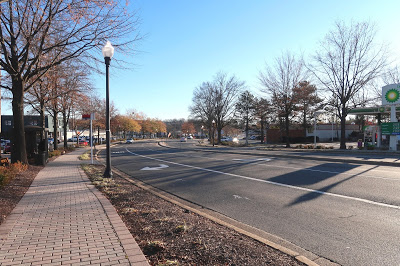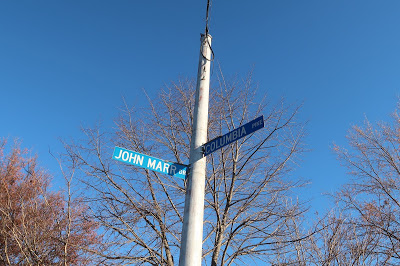History Commission documents Confederate place names in Fairfax County
The Fairfax County Board of Supervisors had requested the report in response to the national movement in recent months calling for the elimination of Confederate monuments.
In June, the board approved a motion by Supervisors Dalia Palchik (Providence) and Walter Alcorn Hunter Mill) directing the History Commission to inventory all names of streets, buildings, monuments, and other assets in the county associated with the Civil War and the Confederate cause.
The History Commission presented the report to the board’s Land Use Committee on Dec. 8.
“We didn’t make any recommendations. We just did the research,” said Barbara Peters, the Mason District representative on the History Commission. It’s up to the board to decide whether any names should be changed.
“At this time there is no definitive action being taken regarding changing names until we have a process in place engaging the public,” said Aryeh Kalender, community outreach director in Palchik’s office. If there is any proposal to change the name of a street, “residents of that street will have a major voice in any changes that happen.”
The board could create a forum for public involvement for changing the names of county assets and might decide to focus on major roadways, such as Lee Highway, which is named for Gen. Robert E. Lee, commander of the Confederate army.
Peters doesn’t think there will be a movement to change the names of residential streets. “If you’ve lived on a street for 30 years and didn’t know it was named for a Confederate, it’s hardly worth getting upset about it now.”
John Marr Drive
Following a thorough analysis, the History Commission concluded that John Marr Drive in central Annandale is likely named for the Confederate soldier John Quincy Marr, even though Marr didn’t have any connections to Annandale.
On March 26, 1964, Katherine and Godfrey Munter sold the property where the first portion of John Marr Drive would be constructed to the County Investment Co. By August 1967, County Investment made a Deed of Dedication that included plans for a newly constructed road named John Marr Drive. The road also first appears on a county tax map in 1967.
Annandale has a history of naming streets after local developers. In the 1950s, there was an Annandale real estate and development company called Marr Inc. The officers and directors included Gareth M. Neville, president; Harriet R. Webb, vice-president; John C. Webb, secretary; and June V. Neville, treasurer. There was nobody named John Marr associated with the company.
Since County Investment’s registered location was in the Town of Fairfax, the report states, “the likely explanation for the selection of the name ‘Marr’ was because of the town’s association with John Quincy Marr, the alleged first Confederate soldier killed in the Civil War at the Fairfax Courthouse.” A monument to Marr was built on the courthouse grounds in 1904 and was removed earlier this year.
Related story: Fairfax County board votes to remove Confederate monument
In 1958, Marr Inc. changed its registered office to 106 N. Payne St. (present-day Chain Bridge Road) in Fairfax. That was also the address for the Bauknight, Prichard, McCandlish & Williams law office.
William C. Bauknight was vice president of Marr Inc. in 1958 and was also the initial registered agent of the County Investment Co. when it was incorporated in March 1959.
After the John Marr Drive property was acquired by County Investment, on March 26, 1964, Marr Inc. was dissolved less than three months later on June 1, 1964.
“It seems likely that with Bauknight’s involvement in both corporations and with the registered office of both corporations being catty-corner to the Marr Monument, that the street, John Marr Drive, was named for the Confederate soldier,” the report states.
 |
| John Marr Drive in Annandale |
When John Marr Drive was platted in August 1967, County Investment’s address was listed on the plat map as 4917 Bradford Drive in Annandale, the residence of Eugene T. Smith. It is unclear what Smith’s involvement with the company was.
Vincent A. Sweeney was the vice president of the company at the time as well. Sweeney was a founding member and executive vice president of the Annandale-based Suburban Savings & Loan Association beginning in 1957. County Investment Co. was dissolved on July 2, 1970.
The History Commission explored other theories about the origin of the name John Marr Drive but rules them out:
- The subdivision adjacent to John Marr Drive is Crestwood Manor, built in 1959 by Crestwood Construction Corp. There were no John Marrs affiliated with that firm as the principals were Bernard Steinberg, E. Carl Hengen, and Roger Hildeen.
- The houses south of John Marr Drive on Sipes Lane were known as Fairdale. They were developed in 1949-1950 by Reliance Homes of Washington. Reliance was headed by Charles B. Lawrence Jr.
- The houses at the end of John Marr Drive on McWhorter Place were built by James A. McWhorter, a developer and surveyor. He owned the Annandale Water Co. and built Annandale Shopping Center.
- Richmarr Construction Co., which built many houses in the area and has “Marr” in its name, was founded and headed by Richard Kirkstein and Marvin Kay.
The earliest Annandale directory in Fairfax County Public Library’s Virginia Room dates from 1966. It does not list anyone named John Marr living in Annandale, and there are no John Marrs listed in the Northern Virginia White Pages for 1962-1963.

A review of land deeds and maps show no one named Marr owned this piece of land before the County Investment Co. purchased it.
The John Marr Drive Professional Center Condominium, at 4534b John Marr Drive, was built in 1980. It was named for its location on John Marr Drive, and indirectly, for John Quincy Marr.
Broyhill Crest
When the Broyhill Crest community was developed in 1951-52 by M.T. Broyhill & Sons, nine of the 15 streets in the original section were named for Confederates:
- Early Street – Gen. Jubal Early.
- Ewell Street – Gen. Richard Stoddert Ewell.
- Herbert Street – Arthur Herbert, served as a captain and colonel in the Confederate army. He was also a co-founder of the Burke & Herbert Bank.
- Longstreet Court – Lt. Gen. James Longstreet.
- Murray Lane – John Edward Murray (1843-1864), known as the youngest general in the Confederate Army although he was never promoted to that rank; killed in the Battle of Atlanta in July 1864. Murray Lane was originally platted as Oakwood Street in 1950 but was renamed Murray Lane by the time the development was completed.
- Pickett Court – Brigadier Gen. George E. Pickett.
- Rodes Court – Brigadier Gen. Robert E Rodes.
- Stuart Court – Brigadier Gen. James Ewell Brown (J.E.B.) Stuart.
- Wayne Drive – Brigadier Gen. Henry C. Wayne.
M.T. Broyhill & Sons was co-owned by Marvin T. Broyhill, M.T. Broyhill Jr., and Congressman Joel Broyhill, a conservative Republican. They built thousands of houses in Northern Virginia during the post-World War II housing boom.
During the early 1950s when Broyhill Crest was developed, many leaders in Fairfax County were engaged in efforts to oppose school integration and Civil Rights legislation.
Other Confederate names in Mason District
The History Commission report lists other assets in the Lincolnia area with a Confederate association:
- The Beauregard Condominium at 4810 Beauregard Street – named for Beauregard Street, which is named for Confederate Gen. Pierre Gustave Toutant-Beauregard. He designed the Confederate battle flag.
- Bragg Street – Brigadier Gen. Braxton Bragg.
- N. Chambliss Street – Brigadier Gen. John Randolph Chambliss Jr.
- N. Rosser Street – Brigadier Gen. Thomas Lafayette Rosser.
As an aside, Jayhawk Road in the part of Annandale in Braddock District, has a Civil War connection, too. Jayhawks were an antislavery, pro-Union group before the war.
Ravensworth
The Ravensworth subdivision in the North Springfield area adjacent to Annandale was constructed in 1959-1965.
The streets are believed to be named by Carl Hellwig of Springfield Surveys. He was an amateur Civil War historian who surveyed the development and designed the layout of the streets. Streets in Ravensworth with a Confederate connection include:
- Bullock Lane – Commander James D. Bullock (Bulloch) was sent to Britain for the Confederacy, where he served as a secret agent and was considered “the most dangerous man in Europe.” He also oversaw the South’s covert shipbuilding and logistics program overseas and masterminded the deconstruction of 130 Union ships.
- Drayton Lane – Brigadier Gen. Thomas F. Drayton, a lifelong friend of President Jefferson Davis, commanded Drayton’s Brigade at the battles of Second Manassas, South Mountain, and Antietam.
- Penley Place – Luther L. Penley enlisted in the Confederate North Carolina Infantry and was part of the “Watauga Marksmen.”
- Slidell Lane – In December 1861, Union naval forces captured John Slidell of Louisiana and James Murray Mason, two Confederate envoys, on a British steamer. The British Prime Minister demanded their release and sent 11,000 British troops to Canada who were prepared to act if they were not freed. Lincoln released them on Christmas Day.
- Ravenel Lane – Henry William Ravenel, a South Carolina planter, kept a journal on Civil War life which was widely read after the war.
Several streets in the Ravensworth neighborhood are named for leaders in the Union army, including Ellet Road (Col. Charles Ellet), Foote Lane (Commodore Andrew Foote), Hallek Place (Gen. Henry W. Halleck), Nutting Drive (Captain Lee Nutting), Sedgwick Lane (Gen. John Sedgwick).
Other streets in Ravensworth are named for Civil War battle sites or forts, including Port Royal Road, Carrick Lane, Adair Lane, Pillow Lane, and Ringold Place.


Ok, change them all……so who's going to pay for all of this?
I thought the same thing who will pay. The tax payers!!!
Wow. I grew up on Longstreet Ct in the '50s and '60s. I knew the whole neighborhood was named for Confederates. Never thought much of it. Hope they don't feel the need to wipe it out.
I think they should leave it alone!! Most people in this area have no idea who the streets are name after!! Tax payers money can be better spent!
They are mistaken about Herbert Street. Herbert Street, Marvin Street, and Joel Drive in the Broyhill Crest neighborhood were named after Marvin T. Broyhill's sons. They were the developers of that neighborhood.
I really appreciate the research, the effort, and the reporting. I hope the County takes the lead and starts working through these names (with the exception of Broyhill's sons – what's a developer to do?). Furthermore, I am more than glad to pony up my taxes for this type of effort – although I find that particular concern to be wildly misplaced as name changes will hardly even show up in our budget.
Oh No,
God save my delicate soul, i am living in a street named by someone who fought to shape the face of this nation.
Please smart, enlighten, sensitive libtards, please save me and my gentle soul of the carnage of living on a street with such name.
Nothing is more pity than a nation apologizing for it's existence.
well done America.
Don't worry it's still taught at our public schools.